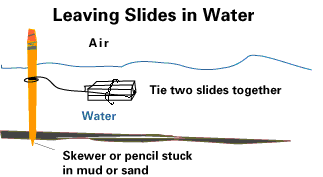
HOW TO COLLECT BACTERIA THAT WILL ATTACH TO SLIDES
(2-6 weeks; this technique also works in wells)

The red precipitates of iron made by Gallionella ferruginea
also coat wellheads such as this one at Muddy Creek, Md.
Equipment
Two microscope slides, magic marker or diamond scribe, wire, fishing line
or rubber bands, pencils or bamboo skewers, something to put slides in (slide
box, centrifuge tube, slide mailer), flagging for trees.

Microscope slides left in red flocs (bottom) and near black-coated
rocks (top) become colonized by the iron- and manganese-precipitating bacteria.
Procedure
1. Take two microscope slides to make a slide set; mark date or place
code on both of them (or else write collecting date and place code in your
field notebook).
2. Put the two microscope slides back-to-back with dates on the inside
surfaces.
3. Tie wire or string around them as if you were wrapping a package.
4. Find a place in a creek where rocks are coated black. The black
is usually manganese. (The best place to look is in the shallow part of
the stream where the water flows swiftly; these areas are called riffles.)
5. Tie loose end of wire around tree roots (best), pencils, or bamboo
skewers (skewers are less likely to be noticed and disturbed), and leave
the slides there in the creek.
6. Tie flagging to a nearby tree so you can find your samples again
(tie loosely so as not to hurt the tree).
7. Come back 2-6 weeks later and retrieve your slides. (Remember
to take the flagging away when you are done.) In wells, make sure you leave
the slides in the zone of oxidation.

Rocks in riffles coated with black manganese oxide, Cosca Regional
Park, Md. The bacteria precipitating the manganese are Leptothrix discophora.
Collecting Hint

 Contents
Contents
"Viewing Techniques through a Microscope"
Contact: Norrie Robbins
[an error occurred while processing this directive]





